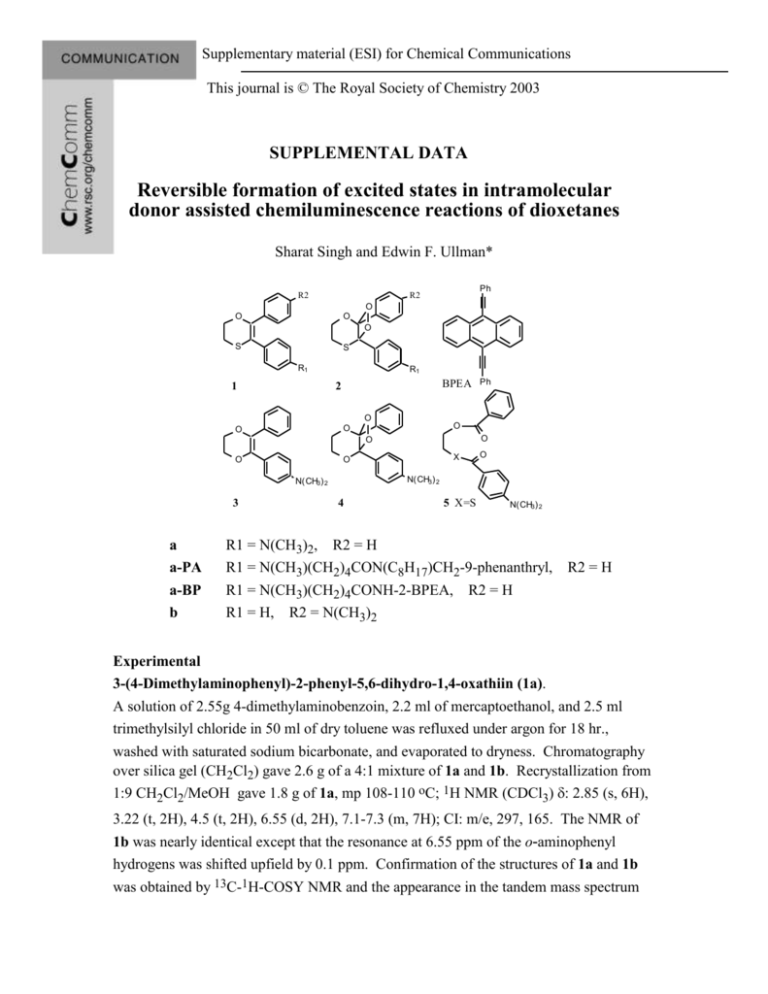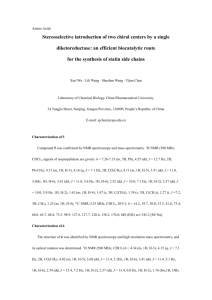Experimental details - The Royal Society of Chemistry
advertisement

Supplementary material (ESI) for Chemical Communications This journal is © The Royal Society of Chemistry 2003 SUPPLEMENTAL DATA Reversible formation of excited states in intramolecular donor assisted chemiluminescence reactions of dioxetanes Sharat Singh and Edwin F. Ullman* R2 Ph R2 O O O O S S R1 1 R1 BPEA 2 O O O O O O O a a-PA a-BP b X O O N(CH3) 2 N(CH3) 2 3 Ph 4 5 X=S N(CH3) 2 R1 = N(CH3)2, R2 = H R1 = N(CH3)(CH2)4CON(C8H17)CH2-9-phenanthryl, R1 = N(CH3)(CH2)4CONH-2-BPEA, R2 = H R1 = H, R2 = N(CH3)2 R2 = H Experimental 3-(4-Dimethylaminophenyl)-2-phenyl-5,6-dihydro-1,4-oxathiin (1a). A solution of 2.55g 4-dimethylaminobenzoin, 2.2 ml of mercaptoethanol, and 2.5 ml trimethylsilyl chloride in 50 ml of dry toluene was refluxed under argon for 18 hr., washed with saturated sodium bicarbonate, and evaporated to dryness. Chromatography over silica gel (CH2Cl2) gave 2.6 g of a 4:1 mixture of 1a and 1b. Recrystallization from 1:9 CH2Cl2/MeOH gave 1.8 g of 1a, mp 108-110 oC; 1H NMR (CDCl3) 2.85 (s, 6H), 3.22 (t, 2H), 4.5 (t, 2H), 6.55 (d, 2H), 7.1-7.3 (m, 7H); CI: m/e, 297, 165. The NMR of 1b was nearly identical except that the resonance at 6.55 ppm of the o-aminophenyl hydrogens was shifted upfield by 0.1 ppm. Confirmation of the structures of 1a and 1b was obtained by 13C-1H-COSY NMR and the appearance in the tandem mass spectrum Supplementary material (ESI) for Chemical Communications This journal is © The Royal Society of Chemistry 2003 of 1a of a fragment corresponding to Me2NC6H4CS (m/e =164), and in the tandem mass spectra of 1b and 3, of a fragment corresponding to Me2NC6H4CO (m/e =148). 2-(4-Dimethylaminophenyl)-3-phenyl-5,6-dihydro-1,4-thioxene (1b). The regiochemistry of 1a and 1b was further established by regio-specific preparation of 1b by stirring a mixture of 2.71 g of 1-(2-chloro--phenylacetyl)-4-dimethylaminobenzene1, 2.34 g mercaptoethanol, and 1 g of potassium carbonate in 10 ml of dry acetone under argon at room temperature for 24 hr and then adding saturated bicarbonate and ethyl acetate. The residue obtained upon evaporation of the organic layer was chromatographed on silica gel with 8:2 CH2Cl2/EtOAc to give 2.0 g of p-(2hydroxyethylthio--phenylacetyl)dimethylaminobenzene. 1H NMR (CDCl3) 2.65 (t, 2H), 3.0 (s, 6H), 3.65 (t, 2H), 5.6 (s, 1H), 6.55 (d, 2H), 7.3 (m, 5H), 7.8 (d, 2H). Refluxing this material in 35 ml of toluene with 1.6 ml of trimethylsilyl chloride for 3 hr followed by washing with bicarbonate, evaporation of the solvent, and chromatography (CH2Cl2) gave a product which when recrystallized from 1:9 CH2Cl2/MeOH yielded 2.4 g of 1b. 1H NMR (CDCl3) 2.85 (s, 6H), 3.22 (t, 2H), 4.45 (t, 2H), 6.45 (d, 2H), 6.95 (d, 2H), 7.2 (m, 5H); CI: m/e 297, 149; MS-MS: m/e 148 9-(N-Octyl)-aminomethylphenanthrene. A solution of 1.03 g 9phenanthrenecarboxaldehyde in 2 ml of MeOH was added to a solution of 5.0 ml of octylamine and 1.6 g of trimethylsilyl chloride in 50 ml methanol that had been preincubated for 10 min. Solid NaCNBH3 (628 mg) was then add and the mixture stirred overnight at room temperature, added to saturated bicarbonate, and extracted with ethyl acetate. Chromatography on silica gel (CH2Cl2) yielded 1.2 grams of the amine. 1H NMR (CDCl3) 0.4 (t, 3H), 0.9 (m, 12H), 2.25 (t, 2H), 3.8 (s, 2H), 7.25 (m, 6H), 7.7 (dd, 1H), 8.2 (dd, 2H); m/e 319. 3-[4-(N-Ethoxycarbonyltetramethylene-N-methylamino)phenyl]-2-phenyl-5,6dihydro-1,4-oxathiin. The conditions for preparation of 1a were used except that 1.8 g of 4-(Nethoxycarbonyltetramethylene-N-methylamino)-benzoin1 was used in place of dimethylaminobenzoin and heating was continued for 30 hr. Work up of the product as before and chromatography on silica gel (CH2Cl2)/ethyl acetate) gave as a pale yellow oil, 1.2 g of 1 (R1 = N(CH3)(CH2)4COOC2H5, R2 = H); 1H NMR (CDCl3) 1.5 (m, 4H), 2.5 (t, 2H), 2.8 (s, 3H), 3.3 (m, 4H), 4.5 (t, 2H), 6.5 (d, 2H), 7.1 (d, 2H), 7.3 (m, 5H); Supplementary material (ESI) for Chemical Communications This journal is © The Royal Society of Chemistry 2003 CI:m/e M+, 411, 279 (MS-MS); max (toluene) 330 nm ( 76,000). 3-[4-(N-Carboxytetramethylene-N-methylamino)phenyl]-2-phenyl-5,6-dihydro-1,4oxathiin [1 (R1 = N(CH3)CH2)4COOH, R2 = H)] A solution of the above ester in 20 ml of THF containing 10 ml of 2.0 N NaOH was incubated for 24 hr under argon at room temperature and then neutralized with 1.0 N HCl. The product, obtained by extraction with ethyl acetate followed by evaporation of the solvent, was used directly in the preparation of 1a-PA and 1a-BP. 3-[4-(N-Carboxytetramethylene-N-methylamino)phenyl]-2-phenyl-5,6-dihydro-1,4oxathiin, 9-(N-octyl)-aminomethylphenanthrene amide(1a-PA). 1 (R1 = N(CH3)(CH2)4COOH, R2 = H) (120 mg), 64 mg of carbonyl diimidazole and 20 mg of 4-dimethylaminopyridine in 20 ml of dry THF was stirred for 2 hr at room temperature. 9-(N-Octyl)-aminomethylphenanthrene (160 mg) in 2 ml of THF was then added and the mixture stirred an additional 16 hr. The mixture was worked up as above. Purification by TLC (1:1 ethyl acetate:hexane) yielded 80 mg of 1a-PA. 1H NMR (CDCl3) 0.7 (t, 3H), 1.3 (m, 12H), 2.2 (t, 2H), 2.7 (t, 2H), 2.8 (s, 3H), 3.3 (m, 4H), 4.3 (s, 2H), 4.5 (t, 2H), 6.5 (d, 2H), 7.2 (m, 7H), 7.7 (m, 6H), 8.2 (dd, 2H), 8.7 (dd, 2H); m/e 684. 3-[4-(N-Carboxytetramethylene-N-methylamino)phenyl]-2-phenyl-5,6-dihydro-1,4oxathiin, 2-amino-9, 10-bis-phenylethynylanthracene amide (1a-BP). 1 (R1 = N(CH3)(CH2)4COOH, R2 = H) (120 mg) in 5 ml of THF and 50 ml of oxalyl chloride was incubated at 4oC for 3 hr and then evaporated in vacuo. The residue was stirred at room temperature with 395 mg of 2-amino-9,10-bis-phenylethynylanthracene (Aldrich) and 2 drops of triethylamine in 25 ml of dry THF for 24 hr. Purification by TLC (9:1 CH2Cl2:hexane) yielded 150 mg of a yellow glassy solid. 1H NMR (CDCl3) 1.6 (m, 6H), 2.5 (t, 2H), 2.9 (s, 3H), 3.3 (dd, 2H), 3.45 (t, 2H), 4.5 (dd, 2H), 6.55 (d, 2H), 7.0 (d, 2H), 7.2 (m, 5H), 7.7 (m, 15H); m/e 758. Chemiluminescence spectra and relative quantum yields. Solutions of 0.1 mM of the oxathiins and 1M tetrabutyl-bis-(trihexylsiloxy)silylphthalocyanine in square cuvettes silvered on two sides were placed in a Spex Fluorolog Spectrofluorometer fitted with a thermostatted sample holder and a magnetic stirrer. The solutions were maintained at 25oC and irradiated with the excitation beam wavelength set at 680 nm (slit 10nm, 640 Supplementary material (ESI) for Chemical Communications This journal is © The Royal Society of Chemistry 2003 nm cutoff filter). Spectra were recorded during irradiation. The observed spectra were corrected by subtracting a blank obtained from a solution with no oxaathiin present and by correcting for signal decay during the scan by means of an auxiliary detector that monitored spectroscopically unresolved emission with time. The oxathiins reacted at equal rates with singlet oxygen and were converted quantitatively to the diester 5 derivatives. Relative quantum yields therefore could be obtained from the chemiluminescence spectra of each of the oxathiin derivatives by irradiating with the sensitizer for sufficient time for the emission to reach a steady state and correcting the spectra where necessary for the wavelength sensitivity of the phototube and inner filter effects of the acceptor. Relative quantum yields for energy transfer from decay of 4 to europium tris-(4,4,4-trifluoro-1-thienyl-1,3-butadione)-4,7-diphenyl-1,10-phenanthrolene (Eu(TTA)3DPP)1 were determined in a similar manner by exciting each solution of 3 for the same time period. This yielded identical amounts of 4. Emission during the relatively slow decay of the 4 that was generated was monitored immediately after interrupting the excitation beam. Absolute quantum yield measurements. Fluorescence quantum efficiencies were measured on a pre-calibrated Perkin Elmer 650-40 fluorometer relative to quinine sulfate or fluorescein. Chemiluminescence quantum yields were obtained by measuring the total integrated light output from a known amount of dioxetane using a Spex Fluorolog Spectrofluorometer. A solution of 0.2-1.0 M of the oxathiin and 5-20 M tetrabutylbis-(trihexylsiloxy)silylphthalocyanine in toluene was held at -78oC and irradiated (640 nm cut off filter) for a sufficient time to completely convert the starting material to the dioxetane as determined by TLC. of the ester 5 formed on warming to room temperature. A 0.1 - 0.2 ml aliquot of the cold solution was then injected into 1 ml of dry toluene held at 25oC in a temperature controlled cuvette containing in a light tight box fitted with a phototube and a removable neutral density filter. The total integrated phototube response over 30 sec., corrected for wavelength dependence, was compared to the signal obtained upon injecting luminol into alkaline DMSO (CL = 0.011)2 contained in the same apparatus. References 1 Ullman, E. F.; Singh, S., US Patent 5,578,498. 2 Lee, J.; Seliger, H. H. Photochem. Photobiol. 1965, 4, 1015-1048. Lee, J.; Wesley, A. S.; Ferguson, J. F.; Seliger, H. H. In Bioluminescence in Progress: Proceedings, Supplementary material (ESI) for Chemical Communications This journal is © The Royal Society of Chemistry 2003 Johnson, F. H.; Haneda, Y., Ed.: Princeton University Press: Princeton, NJ, 1966, pp 35-43.











